All boats are different and chances are, like us, you’ll be buying a cruising boat with “previous experience”. That’s great because it means the boat’s been through the initial shakedown. Keep in mind that it’s our experience that brand new boat owners don’t necessarily have a challenge free existence. Sometimes they’re more frustrated because their expectation was that everything aboard their brand new boat would work perfectly… we’ve yet to see a boat where everything works perfectly.
When we bought Winterlude, she was a lightly used almost daysailor without much cruising equipment. We’ve managed to sink the boat so much that we’ve had to raise the waterline twice with all the extra equipment. Since we started almost from scratch, we decided to rig the boat so that either of us could do whatever needed to be done alone if something happened to incapacitate the other.
KISS – Keep It Simple — whatever equipment you decide you can’t live without, realize that you are going to have to maintain it. So pick wisely!
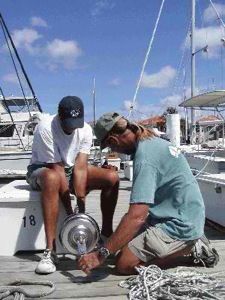
SELF SUFFICIENCY. If at all possible, either install any new systems yourself or watch/help as a professional installs it. That way you’ll have some idea of how it’s installed, how the wiring works, if there are fuses on and on. When our refrigeration compressor went whacko last winter we had a refrigeration pro look at it, diagnose the problem and order a new compressor. We could have saved a bit of money by ordering it online ourselves, but we wanted the pro’s help in installation. David watched the entire ordeal and actually installed the compressor himself, with the pro’s supervision, which I’m sure will be useful in the future.
ELECTRICAL SYSTEM. You cannot finalize an electrical system to support your outfitted boat until you have some idea of what you want aboard. Before you go any further, calculate how many amps you think you’ll use with all the goodies aboard and determine what size of battery bank/recharging capabilities you’ll need. I’ll do another post on the intricacies of this calculation, but be sure to think it through. Otherwise you’ll end up not being able to generate enough amps in a day to recharge your batteries which leads to the dreaded running either the generator or the diesel…. disrupting such calm and peaceful surroundings seems criminal! FYI, we have 6 Trojan T-105 wet cell batteries, 220 watts of solar panels (two 55 watt panels on each side), a KISS Wind Generator, a Honda 2000EU portable generator and, a last resort, a Delco 110 amp alternator. We also have an inverter that we rarely use, but are glad we have for recharging batteries in everything from the laptop and handheld GPS/VHFs to the cell phone. Our recharging capabilities are not optimum – we needed at least 45o watts of solar instead of 220, but we didn’t know that at the time because we hadn’t done any real world calculations of how much energy we’d use daily.Our big amp consumers are:

- Galley: Refrigeration, Microwave, Coffee Maker, Seagull Water Filter. – our Adler Barber Super Cold Machine is great, we have ice cubes and everything, but it eats amps like crazy. Be sure your refrigerator is well well insulated. We rarely use our microwave except as a bread box, but it’s there in case the propane system goes out and I need a backup way to cook. The Seagull Water Filter was a brilliant addition, the water directly from our tanks tastes better than most bottled water, but the filters are expensive. Mr Coffee is definitely a luxury every morning.
- Spectra Watermaker – get the highest gallon per hour model that you can afford and fit into whatever space is allotted.
- Laptop Computer/Navigation Systems – laptops just seem to be power hogs. I’ve had Dell, Acer, EEEpc and Macs and all seem to consumer vast quantities of power to recharge.
- Radar, Lights (we’re replacing the lights with LEDs gradually so this is not nearly the amp hog as it used to be)
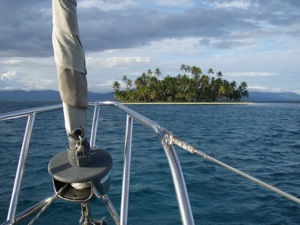
GO NOW! FORGET ALL THIS STUFF! One caveat for this post. You DO NOT NEED ALL THIS STUFF TO GO CRUISING! Go now, you’ll figure it out. If cruising is your dream, go do it!
Stay tuned! Tomorrow is Part II – Sailing and Safety Equipment and Wednesday is Part III – Outfitting for Your Lifestyle
I’m sure I’ve forgotten a zillion things — anyone have other tips for outfitting the boat before going cruising? Comments? THX! Jan
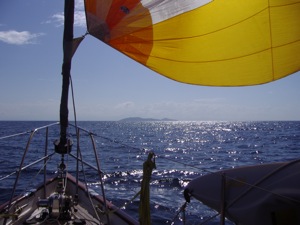

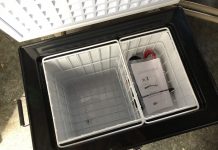








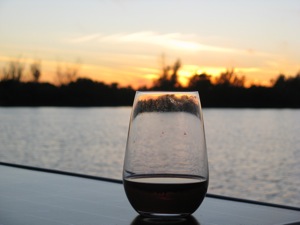


Great post, but I’m wondering what you mean by ‘raise the waterline’?
Hi Sarah! The point where the boat floats in the water is called the waterline. When we bought Winterlude she had very little cruising equipment, she was basically a daysailing boat. As we added cruising equipment (the Monitor Windvane, new anchor chain & anchors, solar panels, the KISS wind generator, the arch, etc), the boat got heavier and sank lower in the water. There was an inch or so now under the water touching the hull where it didn’t have bottom paint — and without the paint, that section grows slime, some barnacles and worse much quicker than the rest of the bottom with the bottom paint. So when we refer to “raising the waterline” we mean that we’re bringing the antifouling bottom paint up higher on the side of the boat so that where the water touches the boat as it floats has bottom paint. 🙂 We’ve changed ours several times over the years as we’ve added more equipment. 🙂 Cheers! Jan
Thanks for the explanation Jan, in hindsight that should have been obvious. I was really worried that we’ve overloaded Tygress as she rides lower in the water than when we bought her, but she’s still within the anitfouling bottom paint. Plenty of room left then for more shoe and book weight 😉
Seems to me that every cruising boat we’ve encountered is overloaded! 🙂
Out of curiosity, are you running your laptops off their ac power supplies? If you get a dc power supply you tend to waste less energy converting your precious dc power to ac in an inverter and then back to dc for your computer.
Agree completely! Actually yes, I am using a small inverter – not the regular boat inverter – but it still takes more than 12v. I’m also looking at getting a solar charger, although it’s pretty expensive, I could use it on extended trips where we’re camping and may not have charging capabilities. I thought I’d call John at HotWire and see what ideas he might offer. THANKS!
hi, it might be late, but here goes. you can buy a universal laptop dc power supply on ebay for $20 it has different tips and different voltages. I use one on my 1977 lancer 28, powers my dell, vaio, and/or 24 inch flat panel tv, I redid my dc panel to resettable breakers and added 2 cigarette ligter sockets and a 4 port usb charger port, I can charge 4 different usb based toys(ipod,tablet,zune,cellphone)
Thanks Capt Theo! I’m still searching for the perfect solution for powering my laptop. I’ll look on ebay. Thanks! Jan